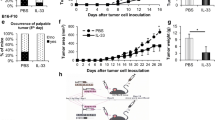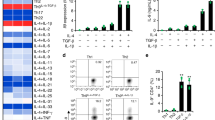Abstract
In previous studies, we found that IFNγ and TNFα generated by activated macrophages stimulate the metastatic potential in F10-M3 cells, a clone isolated from B16-F10 murine melanoma line. In this phenomenon, TNFα promoted the expression of a metastatic phenotype in tumor cells previously primed with IFNγ. Here, we demonstrate that IFNα or IFNβ may replace IFNγ in priming tumor cells. We also noticed that an enhancement of the expression of p55TNFα receptor was associated with the preconditioning of tumor cells with IFNγ and IFNβ. By the use of an appropriate inhibitor, we observed that JAK1 signal transduction pathway was involved in the expression of a metastatic phenotype and of p55TNFα receptor shown in IFNγ- and IFNβ-primed melanoma cells stimulated with TNFα. Furthermore, the activity of the protein kinase C (PKC) was required for IFNγ-primed melanoma cells to express a metastatic phenotype after stimulation with TNFα. In conclusion, our study shows that a metastatic phenotype was expressed in B16 murine melanoma cells stimulated with TNFα regardless of whether the cells were primed with IFNγ IFNα or IFNβ. The molecular events leading to the expression of a metastatic phenotype in F10-M3 melanoma cells are represented by: (a) an enhanced expression of p55TNFα receptor in IFNs-primed tumor cells dependent on JAK1 signal transduction pathway; and (b) an intact PKC activity during TNFα stimulation.





Similar content being viewed by others
References
Liotta LA, Kohn EC (2001) The microenvironment of the tumour-host interface. Nature 411:375–379
Fidler IJ (2002) The organ microenvironment and cancer metastasis. Differentiation 70:498–505
van Kempen LC, Ruiter DJ, van Muijen GN, Coussens LM (2003) The tumor microenvironment: a critical determinant of neoplastic evolution. Eur J Cell Biol 82:539–548
Hsu MY, Meier F, Herlyn M (2002) Melanoma development and progression: a conspiracy between tumor and host. Differentiation 70:522–536
Andreasen PA, Kjoller L, Christensen L, Duffy MJ (1997) The urokinase-type plasminogen activator system in cancer metastasis: a review. Int J Cancer 1–22
Lync CC, Matrisian LM (2002) Matrix metalloproteinases in tumor-host cell communication. Differentiation 70:561–573
Dranoff G (2004) Cytokines in cancer pathogenesis and cancer therapy. Nat Rev 4:11–22
Robinson CR, Coussens LM (2005) Soluble mediators of inflammation during tumor development. Adv Cancer Res 93:159–187
Lazar-Molnar E, Hegyesi H, Toth S, Falus A (2000) Autocrine and paracrine regulation by cytokines and growth factors in melanoma. Cytokine 12:547–554
Bogenrieder T, Herlyn M (2002) Cell-surface proteolysis, growth factor activation and intercellular communication in the progression of melanoma. Crit Rev Oncol Hematol 44:1–15
Cecconi O, Calorini L, Mannini A et al (1997) Enhancement of lung-colonizing potential of murine tumor cell lines co-cultivated with activated macrophages Clin Exp Metastas 15:94–101
Calorini L, Mannini A, Bianchini F et al (1999) Biological properties associated with the enhanced lung-colonizing potential in a B16 murine melanoma line grown in a medium conditioned by syngeneic Corynebacterium parvum-elicited macrophages. Clin Exp Metastas 17:889–895
Calorini L, Bianchini F, Mannini A et al (2002) IFN gamma and TNF alpha account for a pro-clonogenic activity secreted by activated murine peritoneal macrophages. Clin Exp Metastas 19:259–264
Gattoni-Celli S, Calorini L, Simile M.M, Ferrone S (1993) Modulation by MHC Class I antigens of the biology of melanoma cells. Non-immunological mechanisms. Melanoma Res 3:285–289
Chen TR (1977) In situ detection of Mycoplasma contamination in cell cultures by fluorescent Hoechst 33258 stain, Exp Cell Res 104:255–262
Thompson JE, Cubbon RM, Cummings RT et al (2002) Photochemical preparation of a pyridone containing tetracycle: a Jak protein kinase inhibitor. Bioorg Med Chem Lett 12:1219–1223
Way KJ, Chou E, King GL (2000) Identification of PKC-isoform-specific biological actions using pharmacological approaches. Trends Pharmacol Sci 21:181–187
Cox AD, Garcia AM, Westwick JK, Kowalczyk JJ, Lewis MD, Brenner DA, Der CJ (1994) The CAAX peptidomimetic compound B581 specifically blocks farnesylated, but not geranylgeranylated or myristylated, oncogenic ras signaling and transformation. J Biol Chem 269 (30):19203–19206
Zhuang L, Wang B, Shinder GA et al (1999) TNF receptor p55 plays a pivotal role in murine keratinocyte apoptosis induced by ultraviolet B irradiation. J Immunol 162:1440–1447
Haliska FG, Tsao H, Wu H, Haluska FS et al (2006) Genetic alterations in signaling pathways in melanoma. Clin Cancer Res 12:2301s–2307s
Billiau A (1996) Interferon-gamma: biology and role in pathogenesis. Adv Immunol 62:61–130
Johnson DR, Pober JS (1990) Tumor necrosis factor and immune interferon synergistically increase transcription of HLA class I heavy- and light-chain genes in vascular endothelium. Proc Natl Acad Sci USA 87:5183–5187
Tsujimoto M, Vilcek J (1986) Tumor necrosis factor receptors in HeLa cells and their regulation by interferon-gamma. J Biol Chem 261:5384–5388
Carrel S, Hartmann F, Salvi S et al (1995) Expression of type A and B tumor necrosis factor (TNF) receptors on melanoma cells can be regulated by dbc-AMP and IFN gamma. Int J Cancer 62:76–83
Mattei S, Colombo MP, Melani C et al (1994) Expression of cytokine/growth factors and their receptors in human melanoma and melanocytes. Int J Cancer 56:853–857
Ciotti P, Rainero ML, Nicolo G et al (1995) Cytokine expression in human primary and metastatic melanoma cells: analysis in fresh bioptic specimens. Melanoma Res 5:41–47
Moretti S, Pinzi C, Spallanzani A et al (1999) Immunohistochemical evidence of cytokine networks during progression of human melanocytic lesions. Int J Cancer 84:160–168
Dennis JU, Dean NM, Bennett CF et al (1998) Human melanoma metastasis is inhibited following ex vivo treatment with an antisense oligonucleotide to protein kinase C-alpha. Cancer Lett 128:65–70
La Porta CA, Di Dio A, Porro D Comolli R (2000) Overexpression of novel protein kinase C delta in BL6 murine melanoma cells inhibits the proliferative capacity in vitro but enhances the metastatic potential in vivo. Melanoma Res 10:93–102
Gschwendt M, Muller HJ, Kielbassa K et al (1994) Rottlerin, a novel protein kinase inhibitor. Biochem Biophys Res Commun 199:93–98
Kilpatrick LE, Song YH, Rossi MW, Korchak HM (2000) Serine phosphorylation of p60 tumor necrosis factor receptor by PKC-delta in TNF-alpha-activated neutrophils. Am J Physiol Cell Physiol 279:C2011–C2018
Acknowledgements
This study was funded by grants from MURST 40%––Cofin 2003, Progetto di Ricerca di Ateneo Quota ex-60%, Ente Cassa di Risparmio di Firenze.
Author information
Authors and Affiliations
Corresponding author
Rights and permissions
About this article
Cite this article
Bianchini, F., Mannini, A., Mugnai, G. et al. Expression of a metastatic phenotype in IFNs-primed/TNFα-activated B16 murine melanoma cells: role of JAK1/PKCδ signal transduction factors. Clin Exp Metastasis 23, 203–208 (2006). https://doi.org/10.1007/s10585-006-9030-1
Received:
Accepted:
Published:
Issue Date:
DOI: https://doi.org/10.1007/s10585-006-9030-1




